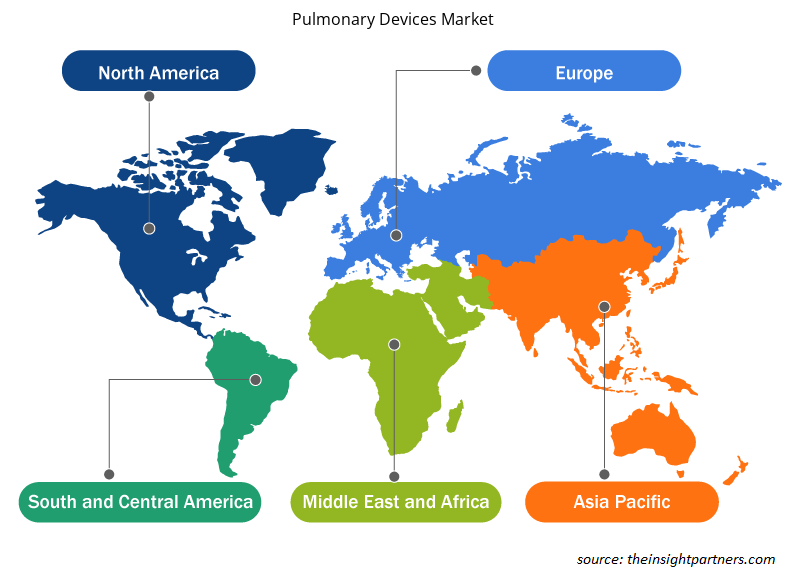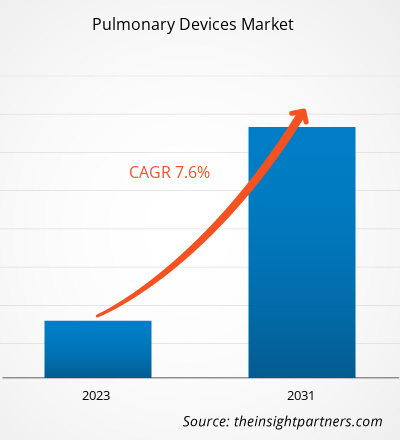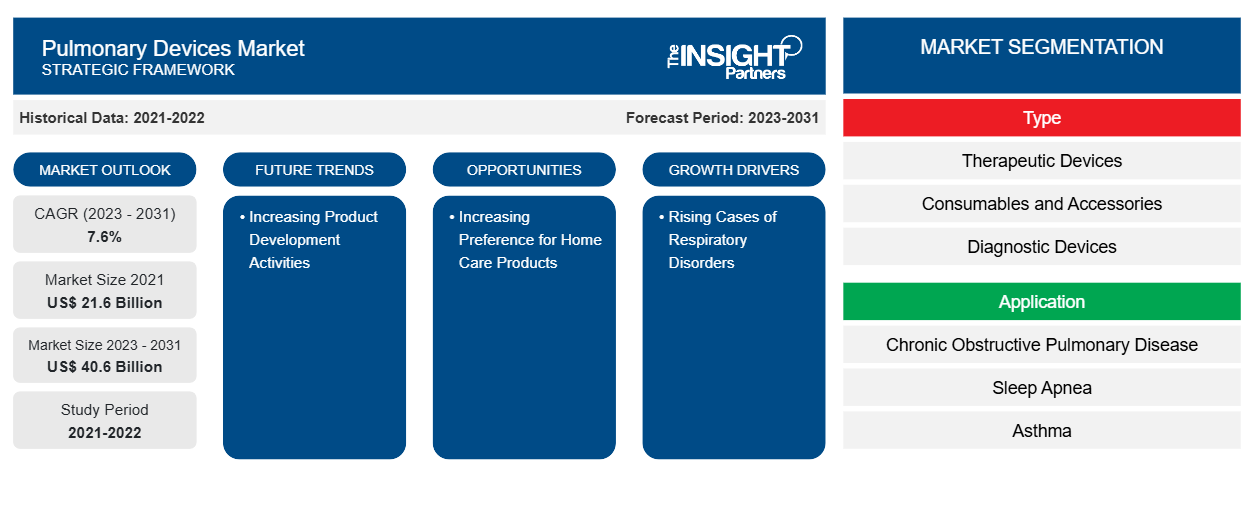Der Markt für Lungengeräte wird auf 21,6 Milliarden US-Dollar im Jahr 2021 und XX Milliarden US-Dollar im Jahr 2023 geschätzt und soll bis 2031 40,6 Milliarden US-Dollar erreichen; für den Zeitraum 2023–2031 wird eine durchschnittliche jährliche Wachstumsrate von 7,6 % erwartet. Die steigende Zahl von Atemwegserkrankungen und strategische Initiativen der Unternehmen sind treibende Faktoren. Die zunehmende Präferenz für Produkte zur häuslichen Pflege wird wahrscheinlich weiterhin der Schlüssel zu den Markttrends für Lungengeräte sein. CAGR of 7.6% in 2023–2031. The rising cases of respiratory disorders and strategic initiatives by companies are driving factors. Increasing preference for home care products will likely remain key to pulmonary devices market trends.
Marktanalyse für pulmonale Geräte
Lungenerkrankungen gehören zu den häufigsten Erkrankungen weltweit. Weltweit leiden Millionen Menschen an verschiedenen Arten von Atemwegserkrankungen und die häufigsten dafür verantwortlichen Faktoren sind Rauchen, genetische Faktoren und Infektionen. Erkrankungen wie Asthma und chronisch obstruktive Lungenerkrankung (COPD), chronische Bronchitis, Mukoviszidose und Lungenkrebs gehören zu den größten Belastungen für die öffentliche Gesundheit. Laut der Weltgesundheitsorganisation (WHO) ist COPD weltweit die siebthäufigste Ursache für schlechte Gesundheit. Daher konzentrieren sich Hersteller auf dem Markt für Lungengeräte verstärkt auf die Einführung verschiedener Strategien wie Produktinnovation, Produkteinführungen und Zulassungen, um ein wettbewerbsfähiges Marktumfeld aufrechtzuerhalten. In Indien brachte Lupin Limited beispielsweise Vilfuro-G auf den Markt, ein Dreifachkombinationspräparat mit fester Dosis zur Behandlung der chronisch obstruktiven Lungenerkrankung (COPD).COPD), chronic bronchitis, cystic fibrosis, and lung COPD is the seventh leading cause of poor health. Therefore, manufacturers in the pulmonary devices market are ramping up their focus on adopting various strategies, such as product innovation, product launches, and approvals, to maintain a competitive environment in the market. For instance, in India, Lupin Limited launched Vilfuro-G, a fixed-dose triple combination drug for managing chronic obstructive pulmonary disease (COPD).
Marktübersicht für pulmonale Geräte
Der asiatisch-pazifische Raum ist der am schnellsten wachsende Markt für Lungengeräte. Das Wachstum wird vor allem durch die höhere Prävalenz von Atemwegs- und Herzerkrankungen, die stationäre Behandlung erfordern, und wachsende Forschungsaktivitäten vorangetrieben. China gehört zu den bevölkerungsreichsten Ländern der Welt und ist das Land mit der höchsten Zahl von Patienten mit Atemwegs- und Herzerkrankungen.
Passen Sie diesen Bericht Ihren Anforderungen an
Sie erhalten kostenlos individuelle Anpassungen an jedem Bericht, einschließlich Teilen dieses Berichts oder einer Analyse auf Länderebene, eines Excel-Datenpakets sowie tolle Angebote und Rabatte für Start-ups und Universitäten.
-
Holen Sie sich die wichtigsten Markttrends aus diesem Bericht.Dieses KOSTENLOSE Beispiel umfasst eine Datenanalyse von Markttrends bis hin zu Schätzungen und Prognosen.
Treiber und Chancen auf dem Markt für Lungengeräte
Steigende Fälle von Atemwegserkrankungen
Asthma, Mukoviszidose, chronisch obstruktive Lungenerkrankung (COPD) und andere Atemwegserkrankungen nehmen weltweit zu. Asthma ist beispielsweise in den meisten Ländern der Welt für 1 % aller Todesfälle verantwortlich. Darüber hinaus ist die zunehmende Luftverschmutzung eine der Hauptursachen für Atemwegserkrankungen wie COPD und Asthma.COPD), and other respiratory diseases is increasing across the globe. For example, Asthma contributes to 1% of all deaths in most countries worldwide. In addition, one of the major causes of respiratory diseases such as COPD and asthma is the rise in air pollution.
Steigerung der Produktentwicklungsaktivitäten – eine Chance
Die wachsende Zahl von Produktzulassungen und -entwicklungen wird die Nachfrage nach Lungengeräten in den kommenden Jahren verstärken. So erhielt das Medizingeräte-Start-up Circadia Health im Juni 2020 die FDA-Zulassung für ein KI-gestütztes Circadia C100-Gerät. Dieses Gerät wird am Krankenbett platziert und ermöglicht eine kontinuierliche, ferngesteuerte Überwachung der Atmung in medizinischer Qualität. Darüber hinaus startet Pulmonx im Februar 2024 die CONVERT II-Studie des AeriSeal-Systems bei COPD-Patienten.Circadia Health received FDA approval in June 2020 for an AI-powered Circadia C100 device. This device is placed at the bedside and allows for continuous, remote, medical-grade monitoring of their breathing. Furthermore, in February 2024, Pulmonx initiates the CONVERT II study of the AeriSeal System in COPD patients.
Der Einsatz von Lungengeräten hat in verschiedenen Ländern Nordamerikas, Europas und Asiens deutlich zugenommen.
Segmentierungsanalyse des Marktberichts für Lungengeräte
Wichtige Segmente, die zur Ableitung der Marktanalyse für Lungengeräte beigetragen haben, sind Typ, Anwendung und Endbenutzer.
- Basierend auf dem Typ ist der Markt für Lungengeräte in Verbrauchsmaterialien und Zubehör, therapeutische Geräte, Diagnosegeräte und Überwachungsgeräte unterteilt. Im Jahr 2023 hielt das Segment der therapeutischen Geräte den größten Marktanteil. Es wird jedoch erwartet, dass das Segment Verbrauchsmaterialien und Zubehör im Prognosezeitraum am schnellsten wachsen wird.
- Basierend auf der Anwendung ist der Markt für Lungengeräte in Asthma, COPD, Schlafapnoe , Infektionskrankheiten und andere unterteilt. Das COPD-Segment hielt im Jahr 2023 den größten Anteil am Markt für Lungengeräte. Darüber hinaus wird erwartet, dass dasselbe Segment im Prognosezeitraum ein deutliches Wachstum verzeichnen wird.
- Basierend auf dem Endverbraucher ist der Markt für Lungengeräte in Krankenhäuser, häusliche Pflegeeinrichtungen und ambulante Pflegezentren unterteilt. Im Jahr 2023 hielt das Krankenhaussegment den größten Marktanteil. Es wird jedoch erwartet, dass das Segment der häuslichen Pflegeeinrichtungen im Prognosezeitraum am schnellsten wächst.
Marktanteilsanalyse für Lungengeräte nach Geografie
Der geografische Umfang des Marktberichts zu Lungengeräten ist hauptsächlich in fünf Regionen unterteilt: Nordamerika, Asien-Pazifik, Europa, Naher Osten und Afrika sowie Südamerika/Süd- und Mittelamerika.
Der nordamerikanische Markt für Lungengeräte ist in die USA, Kanada und Mexiko unterteilt. Die USA hatten im Jahr 2023 den größten Anteil am nordamerikanischen Markt für Lungengeräte. Das prognostizierte Wachstum des nordamerikanischen Marktes für Lungengeräte wird auf Faktoren wie die Präsenz führender Marktteilnehmer und deren Produktentwicklungen, die wachsende geriatrische Bevölkerung und die steigende Prävalenz von Lungenerkrankungen und -infektionen zurückgeführt. So hat beispielsweise das in Großbritannien ansässige Unternehmen ChestPal sein neues digitales Stethoskop ChestPal Pro für medizinisches Personal in den USA auf den Markt gebracht. Dieses Gerät bietet eine automatische Erkennung und Klassifizierung von Rasselgeräuschen und Keuchen und soll Ärzten dabei helfen, genaue und schnelle Diagnosen zu stellen und so möglicherweise die Zahl der Notaufnahmebesuche wegen Atemwegserkrankungen zu reduzieren.
Regionale Einblicke in den Markt für Lungengeräte
Die regionalen Trends und Faktoren, die den Markt für Lungengeräte im Prognosezeitraum beeinflussen, wurden von den Analysten von Insight Partners ausführlich erläutert. In diesem Abschnitt werden auch die Marktsegmente und die Geografie für Lungengeräte in Nordamerika, Europa, im asiatisch-pazifischen Raum, im Nahen Osten und Afrika sowie in Süd- und Mittelamerika erörtert.

- Erhalten Sie regionale Daten zum Markt für Lungengeräte
Umfang des Marktberichts zu pulmonalen Geräten
| Berichtsattribut | Details |
|---|---|
| Marktgröße im Jahr 2021 | 21,6 Milliarden US-Dollar |
| Marktgröße bis 2031 | 40,6 Milliarden US-Dollar |
| Globale CAGR (2023 - 2031) | 7,6 % |
| Historische Daten | 2021-2022 |
| Prognosezeitraum | 2023–2031 |
| Abgedeckte Segmente |
Nach Typ
|
| Abgedeckte Regionen und Länder |
Nordamerika
|
| Marktführer und wichtige Unternehmensprofile |
|
Marktteilnehmerdichte für Lungengeräte: Auswirkungen auf die Geschäftsdynamik verstehen
Der Markt für Lungengeräte wächst rasant, angetrieben durch die steigende Nachfrage der Endnutzer aufgrund von Faktoren wie sich entwickelnden Verbraucherpräferenzen, technologischen Fortschritten und einem größeren Bewusstsein für die Vorteile des Produkts. Mit steigender Nachfrage erweitern Unternehmen ihr Angebot, entwickeln Innovationen, um die Bedürfnisse der Verbraucher zu erfüllen, und nutzen neue Trends, was das Marktwachstum weiter ankurbelt.
Die Marktteilnehmerdichte bezieht sich auf die Verteilung der Firmen oder Unternehmen, die in einem bestimmten Markt oder einer bestimmten Branche tätig sind. Sie gibt an, wie viele Wettbewerber (Marktteilnehmer) in einem bestimmten Marktraum im Verhältnis zu seiner Größe oder seinem gesamten Marktwert präsent sind.
Die wichtigsten auf dem Markt für Lungengeräte tätigen Unternehmen sind:
- Koninklijke Philips NV
- Caire Inc. (Chart Industries)
- Inogen Inc.
- Invacare Corporation
- O2-Konzepte
- Nidek Medical Types, Inc.
Haftungsausschluss : Die oben aufgeführten Unternehmen sind nicht in einer bestimmten Reihenfolge aufgeführt.

- Überblick über die wichtigsten Akteure auf dem Markt für Lungengeräte
Neuigkeiten und aktuelle Entwicklungen zum Markt für pulmonale Geräte
Der Markt für Lungengeräte wird durch die Erhebung qualitativer und quantitativer Daten aus Primär- und Sekundärforschung bewertet, die wichtige Unternehmensveröffentlichungen, Verbandsdaten und Datenbanken umfasst. Im Folgenden finden Sie eine Liste der Entwicklungen auf dem Markt für Lungengeräte:
- Vitalograph, Entwickler von Geräten zur Atemwegsdiagnostik, hat seine VitaloPFT-Serie für Lungenfunktionstests auf den Markt gebracht, die für den Einsatz in der Sekundärversorgung gedacht ist. Diese neue Serie bietet fortschrittliche Lösungen zur Atemwegsdiagnostik für Primär- und Sekundärversorgungseinheiten, die komplexe Lungenfunktionstests erfordern. (Quelle: Serum Institute of India (Vitalograph/Pressemeldung, März 2023)
- Xplore Health Technologies hat mit Airofit Pro das erste Atemmuskeltrainingsgerät seiner Art (RMT) auf den Markt gebracht. Das Produkt entsteht in Zusammenarbeit mit Airofit, Dänemark. Es ist das weltweit erste persönliche, datengesteuerte intelligente Atemtrainingssystem und kostet 34.990 Rupien. Das Gerät kann Ein- und Ausatemerschwernisse trainieren, eine weitere einzigartige Funktion. (Quelle: Reveal Lasers, Pressemitteilung, Oktober 2023)
Marktbericht zu pulmonalen Geräten – Umfang und Ergebnisse
Der Bericht „Marktgröße und Prognose für Lungengeräte (2021–2031)“ bietet eine detaillierte Analyse des Marktes, die die folgenden Bereiche abdeckt:
- Marktgröße und Prognose auf globaler, regionaler und Länderebene für alle wichtigen Marktsegmente, die im Rahmen des Projekts abgedeckt sind
- Marktdynamik wie Treiber, Beschränkungen und wichtige Chancen
- Wichtige Zukunftstrends
- Detaillierte PEST/Porters Five Forces- und SWOT-Analyse
- Globale und regionale Marktanalyse mit wichtigen Markttrends, wichtigen Akteuren, Vorschriften und aktuellen Marktentwicklungen
- Branchenlandschaft und Wettbewerbsanalyse, einschließlich Marktkonzentration, Heatmap-Analyse, prominenten Akteuren und aktuellen Entwicklungen
- Detaillierte Firmenprofile
- Historische Analyse (2 Jahre), Basisjahr, Prognose (7 Jahre) mit CAGR
- PEST- und SWOT-Analyse
- Marktgröße Wert/Volumen – Global, Regional, Land
- Branchen- und Wettbewerbslandschaft
- Excel-Datensatz
Aktuelle Berichte
Erfahrungsberichte
Grund zum Kauf
- Fundierte Entscheidungsfindung
- Marktdynamik verstehen
- Wettbewerbsanalyse
- Kundeneinblicke
- Marktprognosen
- Risikominimierung
- Strategische Planung
- Investitionsbegründung
- Identifizierung neuer Märkte
- Verbesserung von Marketingstrategien
- Steigerung der Betriebseffizienz
- Anpassung an regulatorische Trends























 Kostenlose Probe anfordern für - Markt für Lungengeräte
Kostenlose Probe anfordern für - Markt für Lungengeräte